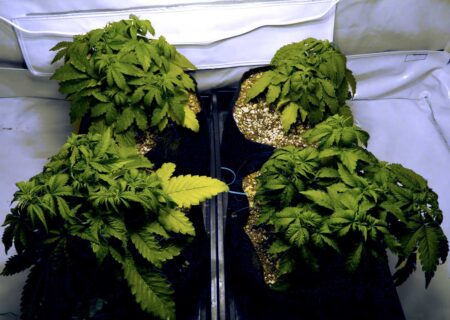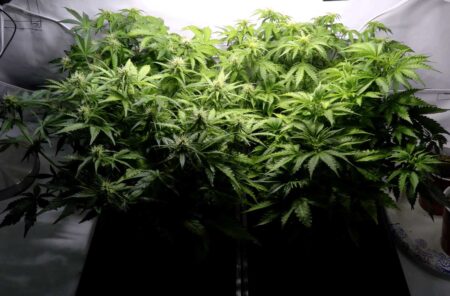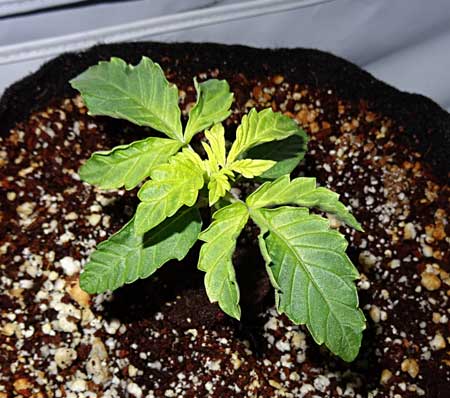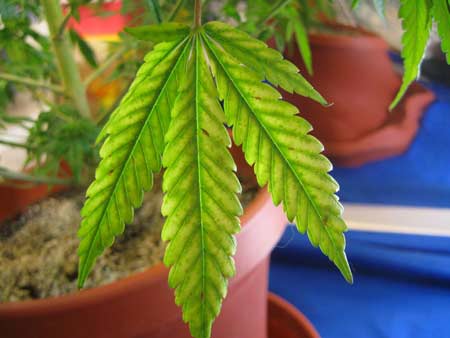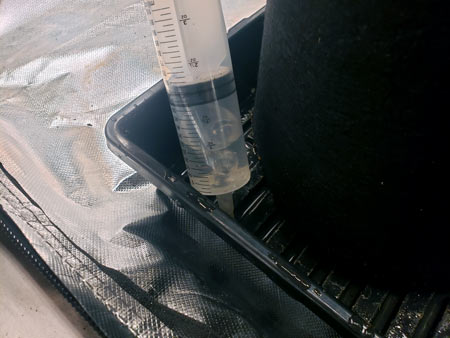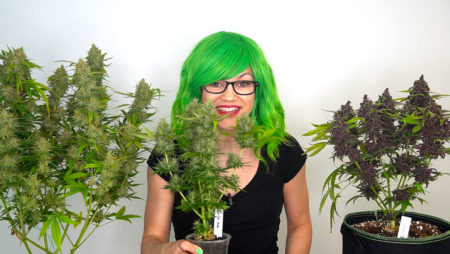by Nebula Haze
Table of Contents
Why Flush Cannabis Plants in the First Place?
How to Flush a Sick Marijuana Plant (without harming it)
How to Fix Incorrect pH Without Flushing – Do this if possible!
Why Should I Flush My Sick Marijuana Plants?
The main reason to flush your sick cannabis plants is to try to correct something wrong at the roots. Flushing means watering your plants with lots of plain water at once. All that extra water leaches out extra nutrients or salt buildup in soil or coco coir. Flushing can also be used to address nutrient deficiencies caused by incorrect pH near the roots. However, flushing is stressful for plants, so it should be avoided unless you have no other choice. This tutorial will teach you when to flush your plants, and when you should address your sick cannabis plants a different way.
Flushing plants with lots of water makes them droopy, and should be avoided if possible. Take good care of plants and you’ll never need to flush. But when it comes to growing, things don’t always go according to plan! If that happens, this tutorial will guide you on what to do.
The following cannabis plants were flushed due to nutrient deficiencies.
When flushing is done properly, your cannabis plants should quickly bounce back and start growing healthy without deficiencies.
Related Article: How to Flush Cannabis Plants Before Harvest to Improve Bud Taste
The most common reasons to flush sicks plants are…
- Fix pH – The pH at the roots is several points too high or too low, causing major nutrient deficiencies
- Flush Out Additives That Made Plant Sick – It’s important to flush a plant that has been watered with something that has made it sick, for example if it is losing leaves because it was recently watered with a pesticide, nutrient or supplement that was too strong.
- Leach Out Time-Release Nutrients – If transplanting isn’t an option, sometimes a grower will flush a plant that is being grown in soil with “time release” nutrients (like Miracle-Gro soil). This idea is to try to leach out extra nutrients (specifically nitrogen) before the flowering stage begins. Too much nitrogen in the flowering stage can give buds a “green” taste as well as actually prevent buds from getting as big as they normally would. Since time-release soils slowly releases nitrogen for months it’s important to flush that out before your plant starts making buds.
If your cannabis plant gets sick the day after you add a new supplement for the first time, you should probably flush your plant to “start fresh” at the roots.
Which Growers Should Flush Their Plants?
Flushing sick plants is for…
- Soil
- Coco coir
- Other soilless mediums
Flushing sick plants is NOT for…
- Hydroponic or DWC grow setups – if you have a nutrient or pH problem, just change the reservoir so it has exactly what you want
How to Prevent the Need to Flush Your Plants
- Start Nutrients at 1/2 Strength – When using a new type of nutrients for your cannabis plants, it’s a good idea to start at 1/2 strength at first. It’s also a good idea to start any pesticides or supplements at half strength until you see how your plant reacts.
- Give More Nutrients to Pale Plants – Increase nutrient dose if the overall plant is starting to look pale or lime green.
- Lower Nutrients for Dark Leaves or Nutrient Burn – If you notice plants are getting dark green in color, try lowering nutrient levels or giving plain water every other watering until their color has improved. If you notice brown crispy tips on the leaves all over the plant, that’s another sign of the plant overall getting too much “stuff” (whether nutrients or supplements) in the water. If the dark leaves or brown tips are the result of too much nutrients, usually you’ll see these symptoms all over the plant instead of just a few leaves.
- Check pH for Other Nutrient Deficiencies – If you seen nutrient deficiencies like yellow leaves, spots, or brown markings, the first step is to check and adjust the pH of the water you give your plants. Maintaining the right pH is the #1 way to prevent nutrient deficiencies. Simply do this one check when you water, and you’ll dramatically reduce the chance you’ll even need to flush (pH being too high or too low is the main reason to flush plants). Learn more about nutrient deficiencies.
- Reduce Light Levels on Sick Plants – When plants are sick, try moving the grow light up a few inches or even a foot. This will help your plant recover more effectively from many nutrient problems, whether you end up flushing the plants or not.
Try to prevent nutrients problems before they happen so you never need to flush!
How to Flush Sick Cannabis Plants
- Make up water with low levels of nutrients (1/4 strength or seedling dose). You want to take out the bad and replace with the good.
- Give 3x the pot size – Use enough water so that you’re giving the plant 3x as much water as the volume of the pot. It may take a little while. Remove all runoff water immediately, you don’t want your plant to suck the bad stuff back up!
- Give regular strength nutrients at the end – Make up one last batch of nutrient water at regular strength, and give this to your plants. You are replacing what you took out with what you want to be there – fresh, pH’ed nutrient water!
- Make sure there is a fan blowing over the top of the growing medium to help it dry out so plants don’t get as droopy from being overwatered. There should be plenty of air circulation in the grow space, with access to lots of fresh air.
- Raise your grow lights up a few inches while your plant is recovering. Your plant definitely needs plenty of light, but you don’t want to make it work too hard during the recovery period.
- Wait a few days for improvement – Although your plant may get droopy at first, you should start to see improvement within a few days. Try not to water it again until the top inch is starting to dry. It’s not recommended to flush a plant two times in a row. After the first flush you should have flushed out what was hurting the plant in the soil. At this point, it’s time to give your plants some TLC while you get things back on track.
How to Fix Incorrect pH Without Flushing
1.) Determine your target pH
- Soil: 6-7 pH
- Coco: 5.5-6.5 pH
2.) Collect runoff
Give your water at the correct pH, and collect runoff water out the bottom. Is the pH too high or low? If the pH is higher or lower than the correct range, don’t panic! At the very least you’re already giving your water at the correct pH from on top. That will help the plant stay healthy while you fix whatever is going on at the roots. Now, onto fixing your pH.
3.) Start fixing the pH the next time you water your plants.
If you already have major nutrient problems, you might consider flushing as stated above. But if you don’t see problems yet, or if you only see just a little bit of leaf discoloration or yellowing, there’s no need to flush. Flushing is very stressful for plants and may prevent them from recovering as fast as they could, so it should be avoided if possible.
Most of the time, if your runoff pH was too high or too low, it’s better to wait until your next watering to start correcting it.
4.) Always give water in the correct pH range, but at the opposite end.
Next time you water your plants give water in the correct range, but at the opposite end of the range to start trying to get it to move in the other direction.
If your runoff water is coming out at 4.5 pH, it means you should water your plants at the high end of your desired pH range. So for soil you would water your plants at 7.0 pH, and with coco you’d water your plants at 6.5 pH.
This ensures that your roots are getting some amount of nutrient water at the correct pH, while also starting to leach out whatever is in the growing medium that’s dragging the pH down.
5.) When pH of water going in and out mostly match, you’re good!
Eventually, your pH is going to start coming out the bottom of the plant in the right pH range, even if it takes a few weeks.
Collect the runoff water and check to make sure the pH isn’t too high or low. Proper pH stops most nutrient deficiencies!
I’ve found that correcting the pH following this process seems to stop most nutrient problems within just a few days, while preventing your plant from getting stressed from a true “flush.”
—
I wish I had known this before I started growing. I’ve done too many unnecessary flushes and unintentionally stressed out my plants. I hope this help guides you to better results in your cannabis growing journey.
Happy growing!
Nebula Haze
Jump to…
How To Get To Harvest As Fast As Possible
Where to Get Marijuana Seeds Online

